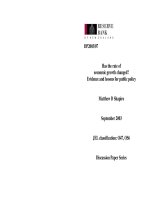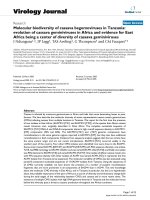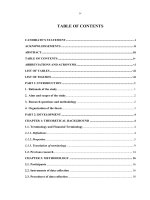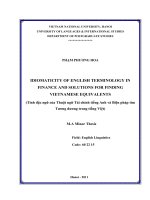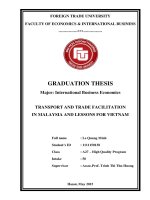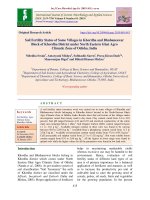Remittance policy of some countries in asia and lessons for vietnam
Bạn đang xem bản rút gọn của tài liệu. Xem và tải ngay bản đầy đủ của tài liệu tại đây (174.4 KB, 28 trang )
Introduction
1. The necessity of thesis
There is always the huge demand for the capital of the economic
growth and the sustainable development such as poverty reduction in
developing countries, especially in countries with low domestic saving rate.
For these countries, domestic resources play a fundamental role, but
external resources is also extremely important for the growth in order to
catch up with other developed economies. In order to meet the capital need,
many countries turn to domestic or international financial markets to issue
government bonds and international bonds or absorb foreign direct
investment (FDI) or receive official development assistance (ODA) but also
less interested in the amount of money that individuals transferred from
abroad to their relatives in the country, that is the remittance. Remittance
tends to be more important for the countries with low and middle incomes.
However, in some countries, remittance flows are limited by the internal
factors of the remittance-receiving countries such as the management policy
of the state, money transfer fees, domestic banking systems. This fact
requires improved policies to optimize the role as well as the potential
benefits of remittance flows to the economy.
In the developing countries such as typical Asian countries: India,
China, Philippines remittance inflows on domestic increase dramatically.
Across the world, the largest remittance-receiving countries in 2013 are
India, China, Mexico, the Philippines and France. In Asian countries, the
three leading countries in attracting remittance were India, China, the
Philippines and Vietnam ranked the fourth. For Vietnam, remittances
become increasingly important. In recent years, remittance flows to
1
Vietnam increased both in absolute and relative terms to GDP. The figures
show that, from 1993 to 2009, remittances have increased by 45 times, from
$ 141 million in 1993 to 6.28 billion in 2009 and Vietnam in 2013 has
reached more than $ 12 billion in remittances to attract from abroad.
Implementing policies to open up the economy, Vietnam has applied
the easing of remittance flows since 1989. Changes in foreign exchange
management policy also create more favorable conditions for the inflow in
general and in particular, remittances. However, policies relating to
remittances still have many shortcomings, which lead to the fact that
Vietnam cannot attract maximum remittances to promote the positive
effects and to minimize the negative impact of remittances.
Learning from the experiences in attracting and using remittances
effectively to promote the economic and social development not only brings
practical significance but also valuable theory. In this situation, the study of
remittances policies of the three countries India, China, Philippines to get
lessons for Vietnam is urgently needed. Therefore, I choose the topic
"Remittance policy of some countries in Asia and lessons for Vietnam"
to be the subject of the thesis.
2. Overview of current reasearch
2
Domestic reasearch:
In recent years, the issues related to financial flows have lured attention
from the research community due to the strong growth of remittances in
Vietnam. A number of case studies on issues are such as works of Le Minh
Tam and Nguyen Duc Vinh (1999), Nguyen Anh Dung & associates (2005),
Dang Nguyen Anh (2005), Pfau & Jiang Qing Long (2006), Nguyen Thi
Thuy Linh (2006), Nguyen Duc Thanh (2007), Do Thi Duc Minh (2007),
Nguyen Minh Thao (2009).
The research by Le Minh Tam and Nguyen Duc Vinh (1999) is
suggestive on remittances. This research detected from the fact that
Vietnamese migrants always send money to support their families and
relatives to afford the living, education costs and investment business;
Pfau and Long's study (2006) shows a shift in the distribution of
remittances in recent years: gradually from urban to rural, from the Red
River Delta and the Southeas to the North China and the Mekong delta. In
addition, the authors also focus on understanding the purpose of the
remittances.
Nguyen Thi Thuy Linh (2006) studied the impact of remittances to
economic development, especially in the household economy. The study
results show that households receiving remittances tend using a larger share
of increased income for the construction and home repair.
Nguyen Duc Thanh (2007) with modeling techniques of general
equilibrium (CGE) analyzes the impact of remittances on the economy of
Vietnam. The results of this study reinforce that the impact of remittances
on the economies of developing countries are complex and they are mixed
among many different trends.
3
Do Thi Duc Minh and associates (2007) have also successfully built a
general equilibrium model (CGE) to perform the first quantitative analysis
of the impact of remittances on the Vietnamese economy.
Other studies mostly considers the perspective of remittances as an item
in the balance of international payments. Thus, they affect the state of the
balance of payments, foreign exchange reserves and the status dollarization,
inflation in these specific conditions. Remittance can be also as a factor in
the process of financial liberalization
Oversea reasearch:
- Concept, nature of remittance / money transfer, remittances classification,
measures to enhance the effectiveness of remittance (Tasneem Siddiqui,
2008).
- Relationship between remittances, poverty and investment (Dilip Ratha
and Samuel Munzele Mainmbo, 2005).
- Role and importance of remittances, money transfer from abroad to
developed and developing countries (Admos O. Chimhowu, Jenifer Piesse,
and Caroline Pinder, 2005).
- Research on the promotion, strengthening, improving infrastructure of the
financial sector to improve receiving of remittances (David C. Grace,
2005).
- Remittances (Nikos Passas and Samuel Munzele Mainbo, and Gina El
Koury Abdusanlam Omer, Omer and Gina El Koury Abdusanlam, 2005)
- Migration, development and remittances issues (Rechard H. Adams Jr.
and John Page, Devesh Kapur, Devesh Kapur, 2005)
- The state of migration and remittances in Pacific-Asia (John Connell and
Richard PC Brown, 2005)
4
- Financial instruments used in mobilizing foreign type (Dilip Ratha and
Sanket Mohapatra Sonia Plaza (2008)
- Analysis of the remittance system (Raul Hernandez-Coss, 2005)
- Limit the prohibition policy of the host country for remittances (Mark P.
Sullivan, 2009)
- The impact of international migration and remittances on poverty (Richard
H. Adams Jr. and John Page, 2005)
3. The purposes and the mission of the reasearch
- Analyze and clarify the theoretical basis of remittances and remittance
policies.
- Assess and analysis of remittance policies of India, China and the Philippines,
to learn theses lessons in attracting, managing and using remittances as an
effective way to promote positive sides, limiting the negative impacts of
remittance flows to the economy and society.
- Assess and analysis the attraction of remittances in Vietnam in recent years,
the thesis draws lessons from three countries India, China and Philippines in
attracting, managing and using remittances in the effective way to make
policies on remittances of Vietnam during the period of economic and social
development.
4. The subjects and the scopes of the reasearch
- Clarifying the rationale of remittances and remittance policy: The concept
of remittances and remittance policies; The nature of remittances
(remittance flows); The socio-economic factors which determine the
foreign source for a country;
5
- On the basis of theoretical overview of remittances, the thesis analyze
remittances of some Asian countries, of which I focus on three typical
countries India, China and the Philippines .
- From policy analyses of three national remittances, comparison of policies
are made to attract remittances from third countries in order to get lessons
for Vietnam in attracting and effectively using remittances for socio-
economic development of Vietnam.
- To demonstrate the point of the thesis, the scope of the dissertation
research sample typical three countries India, China and the Philippines in
the period from 1995.
5. Methodologys
- Using methods in the social sciences, including the method of dialectical
materialism, historical materialism, statistical method, comparative method,
synthetic method of analysis.
- On the basis of the practice of remittance policies of India, China and the
Philippines in order to analyze its impact on the socio-economic
development.
- In addition, the thesis will use statistical tools, charts, popular model to
analyze and prove some claims and scholarly perspectives.
6. The contributions of the thesis
- The synthesis of the common problems of remittances and remittance policy
as a theoretical basis for the study assessed the impact of remittances for socio-
economic development of every country in the process of economic integration
international.
6
- Comparison and evaluation of remittance policy in three countries India,
China and the Philippines in order to draw lessons for Vietnam to attract,
manage and use remittances efficiently.
- The thesis also makes recommendations on policies of Vietnam remittances
during the socio-economic development period in 2020 on the basis of
assessment of the attraction and use of remittances in Vietnam period from
1995 to the present.
7. The structure of the thesis
Besides the introduction, conclusion and reference, texture of the thesis
is divided into three chapters:
Chapter I: Rationale and practice of remittances and remittance policy
Chapter II: Remittances and remittance policies of some Asian countries
Chapter III: Lessons for the planning and implementation of policies
remittances in Vietnam.
CHAPTER I: RATIONALE AND PRACTICE OF REMITTANCES
AND REMITTANCE POLICY
1.1 Overview of remittance
1.1.1 The concept of remittance
International Monetary Fund (IMF) defines remittances "are
goods and financial instruments for which workers live and work
abroad for at least one year transfer into the country." According
to World Bank (WB): "Remittances include cash transfers from
foreign, which sourced from income of workers, migrants abroad,
are shown in the balance of international payments is funds
7
transfers (net) ". Although the transfer of money (Remittances) can
be international or domestic (between different regions of the same
country) but the thesis refers only to the international transfer
(international Remittances). According to Puri & Ritzema (1999),
remittances (international Remittances) can be defined as "the income
of workers abroad sent home."
According to the Decision 170/1999 / QD-TTg of the Prime
Minister dated on 08.19.1999, the definition of remittances has been
explained: "Remittances are the freely convertible foreign currency
which is converted into Vietnam under the form follows: transfer of
foreign currency through authorized credit institutions; transfer of
foreign currency through businesses providing financial services
international postage; individuals who bring foreign currency into
Vietnam. Individuals overseas when entering Vietnam with foreign
currency for Vietnam households abroad must declare to the customs
gate about this amount of foreign currency to beneficiaries in the
country.
Thus, the view of the definition of Vietnam remittances is
consistent with the definition of the World Bank and based on this
consensus view, this definition is the rationale for analysis.
1.1.2 The Overview of the global remittance flow
Across the world, the largest remittance-receiving countries in 2010
are India, China, Mexico, the Philippines and France. According to the
latest report of the World Bank (WB), remittances worldwide in 2013 was
estimated at DOLLARS 534 billion and will increase to 685 billion dollars
in 2015. Developing countries received 406 billion total remittances in
8
2012, up 6.5% compared with 2011. India is the leading in this list with 70
billion dollars, followed by China (66 billion dollars), the Philippines and
Mexico (with 24 billion dollars), Nigeria (21 billion dollars), Greece (18
billion dollars), Pakistan and Bangladesh (with 14 billion dollars).
1.1.3 The factors impacts to the remittance flow among countries
Studies have shown that there are three basic groups of factors that
may impact remittance flows: 1) group of elements influenced by emotional
(altruistic); 2) group of microeconomic (micro-Economic) factors and 3) a
group of macroeconomic factors (macro-Economic)
From these basic factors affecting remittance flows, the cause formation
of remittance flows between countries can be analyzed as follows:
The first reason is the wages gap between rich and poor countries.
The second reason is that people residing abroad wish to return home
investment business with the desire to make a profit and contribute in the
construction and development of homeland.
The third reason is for migrants to send money home for his family.
With this motivation, people abroad reduce anxiety for his family at home.
The fourth reason is related to demographic analysis. As the aging
population, the developing countries will have to find other sources of
labor to boost the economy. The reason is that, without new labor force, the
government cannot afford to pay pensions for increasing amount of elderly
people.
The fifth one caused by the receiving-remittance countries tend to
increase incentives to attract remittances flow which are considered as
foreign currency inflows from abroad.
The sixth cause is for the payment of debts. Regularly, families have to
9
borrow money to cover the travel costs for exported labors or to study
abroad. They hope that they will be able to pay a portion or all of the debt
after a period of study or getting a job. This is essentially the same as an
investment.
The last motivation can be considered is the insurance policy.
Migrants may invest on financial assets in the country they work in, but
they cannot avoid the risk of financial market imperfections. Therefore, an
effective solution to minimize this risk is to transfer money to their
families.
1.1.4 The impacts of remittances to the social and economic
development of developing country
1.1.4.1 Positive impacts of remittances to the social and economic
development of developing countries
The positive contribution of remittances to social and economic
development can be seen in the following points: remittances provide the
effective channel for strong foreign currency, increase foreign exchange
reserves and finance the current account balance deficit; and contribute to
promote investment and consumption. They are the engine of economic
growth with stability and minimize credit risk and debt burden; contribute
to improve the fledgling financial system or transfer both knowledge and
technology. They also contribute to poverty reduction in developing
countries as well as having positive impact on human resources.
Remittances can help families receiving remittances invest more in human
resources as the increase of spending in education and health.
10
1.1.4.2 Negative impacts of remittances to the social and economic
development of developing countries
The basic limitations of remittance flows are expressed such as:
remittances increase dollarization and sensitivity to foreign currency in
the economy; causes obstacles in determining the money supply which
increases risk of inflation. The use of foreign currency from remittances
unsettled; which impact on the labor market. Members of the family can
receive remittances and depend on remittances or ignore labor efforts.
1.2 Overview of the remittance policies
1.2.1ThecConcept and content of remittance policies
Remittance policy is a set of measures, macro and micro policies to attract,
manage and use the resources of remittance effectively for the purpose of
developing the country’s socio-economy.
The content of remittance policy includes:
*) Foreign Exchange Management Policy
*) Policy to encourage foreign settlers and foreign workers to invest in the
country
*) Labor export policy
*) The liberalization of the banking and financial services
*) Remittance services competition
1.2.2 The policies to attract remittance flow to finance for the socio-
economic development of developing countries
11
The first policy is to develop and finalize the basis of international law
through treaties, official bilateral and multilateral agreements and
multilateral with countries and international organizations around the world.
The second reason is to improve the legal framework so as to protect and
create conditions for businesses, intellectuals, and oversea people to work
and invest in their countries. The formation of professional associations is
also encouraged and the cooperation in the community and with foreign
countries is expanded.
Thirdly, actively support the stability and development of residents abroad,
preserve ethnic identity through the expansion of exchanges on many
aspects such as culture, education, sports, donation between domestic and
foreign communities.
Fourthly, the specific situation of community of each country, each area
should be evaluated in order to encourage and motivate timely positive
factors, promote the community's strengths and limit the negative sides. It is
also important to take advantage of remittances for the development of
country.
Fifthly, help overseas people to have access to the policies of socio-
economic development of the country quickly, accurately and properly.
1.2.3 Policies on managing and improving the effectiveness of the
utilization of remittance
Firstly the State implements policies to guide or motivate remittances to
invest in the manufacturing sector and human such as education and public
health to create long-term developmental effects for the country.
12
Secondly, for the exchange rate policy: consider a flexible exchange rate
regime through the relaxation of trading rate band and when necessary can
be gradually adjusted the official exchange rate band, and reduction of
interventions on the foreign exchange market.
Thirdly, on fiscal policy: According the experience of many countries,
while there is an increase of capital inflows, the government need to be
quick and decisive in limiting spending, reduce the impact on total demand
and inflationary pressures.
Fourthly, the completion and development of related policies to attract
overseas investment to strengthen business operations in the country
Chapter II: REMITTANCE AND THE REMITTANCE POLICIES
OF SEVERAL AISAN COUNTRIES
2.1 Remittance and the role of the remittance in Asian countries.
According to World Bank’s report about remittance and global
migration, the average amount of remittance transferred across national
borders has bounced back and increased from 416 billion dollars in 2009 to
440 billion dollars in 2010. The report indicated that 7 of 10 countries
which received the largest amount of oversea remittance respectively are
India, China, Philippines, Pakistan, Bangladesh, Vietnam and Srilanka.
Remittance contributed such an important part to the economy’s recovery
after the crisis period. The amount of money transferred through the
remittance is considered as the second important foreign money sources after
the direct foreign investment of developing countries. Indian, China,
Philippines are the most typical countries for receiving the remittance, hence
13
what are the impacts of these money flows to the development of
socioeconomic of each country? What lessons that Vietnam could draw from
the experience of the attracting and utilizing remittance policy of these
countries?
2.2 The Remittance policy of India, China and Philippines.
2.2.1 In India
2.2.1.1 The remittance policy of India
According to the report of World Bank about the reality of oversea
remittance in India, in 2013, the remittance transferred back to India was 71
billion dollars. For the purpose of transferring the remittance as the valuable
foreign currency used for the development of socioeconomic, India had
implemented many policies for attracting and using the oversea remittance
effectively:
*) The policy for people settling abroad
Based on the fact that the remittance is the money transferred by the
Indian living abroad back to their countries, the Indian government had
implemented many more opening and clearing polices for attracting their
national residents living abroad. In 1998, India issued constructing bond
only for Indian people living oversea. After that, Indian government
enforced "quasi-citizenship" regulations stating that Indian national
residents are received their rights as the domestic people including
travelling in and out the India without visa, owing house and land in India
and receiving the investment incentive only for Indian national residents
living oversea. Additionally, New Delhi government has established the
Department of Indian national residents’ matters for solving their question
frequently, or found Non-Resident Indian - NRI City with modern
14
infrastructure and services around the country. Thanks to these continuous
policies, India attracted so many knowledge specialists serving for the
development of the country.
*) The policy for consumer protection
To increase the transparency and protect customers in the Indian market
for transferring money, the providers of money transferring services need
to: (a) approve a protecting charter for customers published broadly and (b)
appoint the solving for appeal and state the detailed contents of the solving
*) The innovating policy in the financing sector
Innovation for the financing sector based on the liberazed trend
changed the banking activities, created the chance to carry out the active
role of banking system in the economy. The innovation in the banking
system encourages the private investment in banking section, allows the
state bank to sell the share to the free market, and provides the
advantageous conditions for the development of banking system including
the transferring for oversea remittance. The competitive ability of state-
owned banks is improved while facing the adjustment of financing market
and new domestic and foreign private competitors.
*) The role of information department
The in charge departments have the jurisdiction for transferring oversea
remittance enforced consistency policy to protect the ultimate benefit of
people transferring the remittance and ensure the transparency to create the
truthfulness and attract much more oversea remittance transferred back to
the country.
15
2.2.1.2 The impact of oversea remittance to the development of
socioeconomic of India
Firstly, that is the role of oversea remittance transferred from Indian
living abroad as the valuable investment to several core sections, especially
in technology.
Secondly, the role of oversea remittance is reflected indirectly by the
success of Indian business men living abroad contributing to the
development of socioeconomic of the country.
Thirdly, that is the role of oversea remittance in medical section, education
and scientific research.
Fourthly, the motivation for the development of India comes from the
oversea remittance sent to the country for investment in infrastructure, for
helping their family improve their living condition, for manufacture and
trading in small scale, for approaching the modern services that they could
not approach before.
2.2.2 In China
According to WB, each year the remittance transferred to China is very
enormous, accounting for 14% GDP of China. The remittance increased
year by year, in 2000 the oversea remittance reached only 6 billion dollars
and in 2010 China attracted 51 billion dollars which was 9 times higher
than 2000 and based on the report of World Bank, the remittance of China
in 2013 reached 60 billion dollars, ranked the second in Asian and the
world only after India.
2.2.2.1 The remittance policy of China
16
Firstly, China government used the remittance for manufacturing
development through supporting the enterprises in small scale not having
enough condition to have a loan at the banks or credit institution with the
funds namely TVEs (township and village enterprises).
Secondly, China had many efforts in renovating the trading policy to
be more transparent and liberalization i.e. in multiple commitment on legal
framework and regulations mechanism, as well as commitment on opened
market for goods and services. As such, the oversea Chinese could expand
their business and invest to home country.
Thirdly, China government enforced many preferential programmes
about land, recruiting for civil authority system to attract Chinese people
living abroad.
Fourthly, China applied the green card system in recent years. The
foreign talent people would be invited to migrate eternally enter and exit the
country and reside temporally with their passport without visa.
Fifthly, the government issued diaspora bond – a kind of debt issued
by the government in domestic currency and was sold to the Chinese people
living abroad for having the funds to invest into the specific projects. This
could raise the loving country from the migrated people wanting to have the
contribution to develop the country.
2.2.2.2 The impact of oversea remittance to the development of
socioeconomic of China
There are many reasons for the success of economic and social
development of China, including the contribution of remittance flows.
17
Firstly, remittances contribute significantly to the economic growth of
China.
Secondly, through remittances from relatives moved back home, it has
emerged in Mainland movement using remittances to invest in housing,
education and improve the living standard and thus help to economic boom.
Thirdly, China has implemented strategies to promote the potentials of
the oversea Chinese in developing the economic through attracting
brainpower, attracting investment and take the oversea Chinese as a bridge
to bring goods to international markets
2.2.3 In Philippines
2.2.3.1 The remittance policy of Philippines
Philippines is the fourth country attracting remittances in Asia. In
2013, Philippine remittances reached 17 billion dollars. To attract, manage
and effectively utilize their remittances, the Philippine government has
adopted the following policies:
Firstly, professionalizing the labor export policy and turning this area
into a new industry, targeting the national markets requiring high-quality
human resources or the country with a population of aging.
Secondly, the Philippine government grasped the world economic
situation and implemented policies to mobilize varied and flexible
remittances to allow for domestic money remittance easier and less costly.
Thirdly, the growing presence of banks as well as non-bank remittance
organizations of the Philippines also contributes to the increasing number of
remittances of this country.
Fourthly, in the field of labor export, Philippines is particularly
interested in specialized vocational training, and has all the responsibility
18
for their country labors. Therefore, those labors have the chance to integrate
into other countries, including developed countries
2.2.3.2 The impact of oversea remittance to the development of
socioeconomic of Philippines
Remittances have a significant contribution to the socio-economic
development of the Philippines: improving investment environment,
strengthening of spending ways. Philippines has been creating an surprising
economic growth in the global economy crisis; Filipinos living and working
overseas send money to their home country to help improve the lives of
people in the country. Remittances help stimulate domestic consumption
which significantly contributes to the improvement of living standard of
Filipino; remittances contribute to the reduction of poverty.
2.3 Conclusions drawn from the analysis of Remittance policy in India,
China and the Philippines
Remittances have significant impacts to social and economic
development of all three countries receiving inflows by India, China and
Philippines. Remittances have a positive contribution reducing poverty for
families who receive remittances or can help households avoid falling into
poverty. Remittances provide opportunities for investment in new
businesses or expand existing businesses. Remittances can help families
receiving remittances invest more in human capital in the form of increased
spending on education and health. Remittances become an important source
19
of foreign exchange, especially for countries which have fiscal deficits,
foreign debt, often lose the balance of trade and lack foreign investment.
All three countries have adopted various policies to attract remittances
effectively to help the socio-economic development of the country; each
country has distinct points depending on the conditions for developing
socio-economy.
In summary, an overview of the remittance countries in Asia shows
that remittance flow is the biggest benefit that labor-exporting countries
receive from the global labor mobility. In recent years there has been a
rapid growth of remittance flows in relation to other financial flows. It is
clear that while other financial flows are unstable and tend to decrease even
after 2000, remittances have increased steadily. Remittances can have
positive or negative impacts. Remittances can affect issues such as the
problem of poverty and inequality in income, consumption, investment and
household savings, labor markets, human resources and macroeconomic
variables other. All three countries have adopted various policies to attract
remittances effectively and help the socio-economic development of the
country. Each country has distinct points depending on the conditions of
economic development economic conditions of each country.
Chapter III: LESSONS LEARNED FOR PLANNING AND
IMPLEMENTING THE REMITTANCE POLICY I OF
VIETNAM
3.1 Lessons learned from the remittance policies of the three countries
India, China and the Philippines.
20
Through the study of policies to attract remittances from India, China, and
the Philippines, the lessons that Vietnam from the success of those nations
in attracting remittances to promote the socio-economic development of the
country can be generalized as follows:
The first is that the policy on attracting overseas citizen of all three
countries is more and more flexible by year.
Secondly, the lessons of China's remittances to develop production through
supporting small and medium enterprises which are not eligible for loans at
banks or credit institutions through fund called TVEs (township and village
Style).
Thirdly, lessons in attracting overseas talents
Fourthly, the lesson of the labor export policy of the Philippines.
3.2 Status and impact of remittances to socio- economic development of
Vietnam
3.2.1 The legal basis of remittances in Vietnam
Parallel to the process of innovation, economy open-up and international
economic integration, the Party and the Government have identified
Vietnamese people who live and work abroad is an integral part of
Vietnam. Therefore, remittances are an important resource for economic
development. In order to encourage management and effective use of
remittances, the Government and related Ministries and departments have
built many legal documents on management of remittances since 1982.
3.2.2 Methods of remittances transferred in Vietnam
In Vietnam, remittance flows are absorbed through two methods:
remittances through formal channels and non-formal channels.
21
3.2.3 Status of remittance inflows to Vietnam
*) The sources of remittances in Vietnam
Remittances are formed primarily from two sources: Vietnamese
overseas exported labor. The remainder are Vietnam professionals, students
working and studying abroad.
Remittances may be transferred to Vietnam through official channels
and unofficial channels.
*) The distribution of remittances in Vietnam
As reported by the World Bank in 2012, remittances to Vietnam
reached 10 billion dollars and in 2013, reached 12 billion dollars.
Remittances to Vietnam include: + A portion directly to relatives, family
and friends to help them improve their difficult living expenses; + Parts of
remittances focused in the areas of health, education, sponsorship of
projects to refurbish schools, invest capital in private hospitals large scale;
+ A portion of remittances to invest in small and medium enterprises sector
as restaurants, hotels, tourism, rattan handicraft, agro-processing, food
export ; + A portion of remittances are concentrated in a number of
technology areas with high levels of intelligence as field technical
equipment, construction equipment, telecommunications, information ; +
In addition, a large portion of remittances is shifting into the real estate
market and the stock exchange.
3.2.4 Analysis of the impact of remittances on social and economic
development in Vietnam
3.2.4.1 Positive impacts of remittances to economic development -
society in Vietnam
22
Remittances have many positive impacts on socio-economic
development of Vietnam such as remittances are sources (along with
inflows of direct investment FDI) accounted for the largest proportion of
funding from the outside in Vietnam and has tended to increase over the
years. There is an important role for saving, investment and growth; stable
cash flow generating offset current balance; contribute positively to the
development of financial markets because these amounts increase the
supply of capital for financial institutions. They also contribute to solving
the crisis and increase credit reputation; and help increase people's incomes
and contribute to poverty reduction
3.2.4.2 Negative impacts of remittances to the development of economic
and society in Vietnam
Remittances also caused a number of macro-economic instability for
receiving countries such as increasing the supply of foreign currency, local
currency appreciation. In order to avoid appreciation of the domestic
currency, the central bank must buy foreign currency, which increase the
burden on the central bank while the costs increase. In this situation,
remittances causes increased dollarization phenomenon Thus,
remittances have a negative impact on the stability of the macro economy.
23
3.3 Adopting the lessons learned about attracting, managing and
effective use of remittances as India, China and the Philippines in
remittances policies of Vietnam.
The first, remittances are money coming from the overseas to
relatives in the country, India, China and the Philippines have focused on
policies to attract nationals visiting their homeland to encourage remittances.
This policy will improve the living quality of people or invest in production
development contributes to economic and social development of the country.
The second, on the use of remittances for developing China's
production through the support of small-scale enterprises, they are not
eligible for loans at banks or credit institutions through fund called TVEs
(township and village enterprises).
The third, attracting talent from countries overseas Chinese
government is an effective policy. People residing abroad to send remittances
to the country was divided into two groups of subjects: one is the long-term
settlers overseas with potential economic strengths, knowledge, talent, and
two are pure manpower. With two types, the potential of remittances for
socio-economic development of the country really has to come from the first
target group. Hence, policies to attract Chinese talent is a valuable lesson for
remittance policies of Vietnam.
The fourth is about policies to encourage export of Philippines
labor. The labor exported is one of the important channels of remittances,
therefore, promoting labor exported can be one of important policy to
increase remittance flows. This solution, on one hand, settle employment,
vocational training towards intensive learning civilization developed
24
countries, on the other hand, improve home life contributing to the poverty
alleviation
3.4 Policy recommendations on remittances of Vietnam
The first, to accelerate the process of VAT refund; concerned departments
must give clear guidance and administrative procedures for people; shorten
business license registration and driver's license for a period of longer than
expatriates to facilitate long-term business investment; policies must be
specified for each locality.
Secondly, the government should create equitable policies for Vietnamese
despite in any other country. This policy should make them aware of
obligations and rights of a citizen of Vietnam, equality to all other citizens,
which encourages people residing overseas patriotism and desire to invest
contributions in building the country.
Thirdly, the state should have more liberal rules than to buy houses in
Vietnam for Vietnam's foreign residing in doing administrative paperwork,
protecting their legitimate rights.
The fourth, it is necessary to adjust tax policies to ensure that budget
revenues has encouraged the workers with high wages to pay tax with
satisfactory for their labor.
The fifth, the Centre Bank needs more detailed studies to have a basis for
the implementation of exchange rate policy, interest rates and investment
policies to encourage appropriate on the basis of possible orientations for
the implementation extraction and use of remittances more effective.
25
